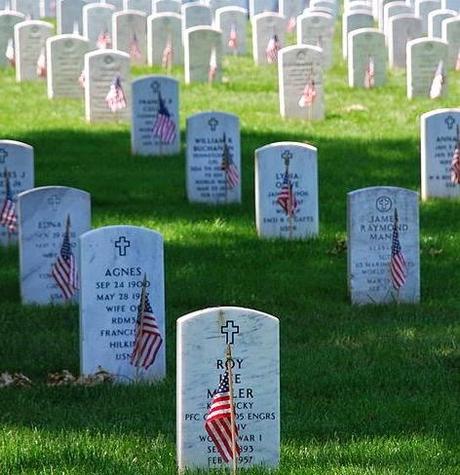
As we pause today to honor those who gave their lives serving in the military of the United States, I thought it might be good to give a little history of this solemn holiday. Here are some excerpts from the holiday's history as told on Wikipedia:
The first widely publicized observance of a Memorial Day-type observance after the Civil War was in Charleston, South Carolina, on May 1, 1865. During the war, Union soldiers who wereprisoners of war had been held at the Charleston Race Course; at least 257 Union prisoners died there and were hastily buried in unmarked graves. Together with teachers and missionaries, black residents of Charleston organized a May Day ceremony in 1865, which was covered by the New York Tribune and other national papers. The freedmen cleaned up and landscaped the burial ground, building an enclosure and an arch labeled, "Martyrs of the Race Course." Nearly ten thousand people, mostly freedmen, gathered on May 1 to commemorate the war dead. Involved were about 3,000 school children newly enrolled in freedmen's schools, mutual aid societies, Union troops, black ministers, and white northern missionaries. Most brought flowers to lay on the burial field. Today the site is used as Hampton Park Years later, the celebration would come to be called the "First Decoration Day" in the North. . .
On May 26, 1966, President Johnson signed a presidential proclamation naming Waterloo, New York, as the birthplace of Memorial Day. Earlier, the 89th Congress adopted House Concurrent Resolution 587, which officially recognized that the patriotic tradition of observing Memorial Day began one hundred years prior in Waterloo, New York. According to legend, in the summer of 1865 a local druggist Henry Welles, while talking to friends, suggested that it might be good to remember those soldiers who did not make it home from the Civil War. Not much came of it until he mentioned it to General John B. Murray, a Civil War hero from Waterloo, who gathered support from other surviving veterans. On May 5, 1866, they marched to the three local cemeteries and decorated the graves of fallen soldiers. It is believed that Murray, who knew General John A. Logan, told Logan about the observance and that led to Logan issuing Logan's Order in 1868 calling for a national observance. . .
The preferred name for the holiday gradually changed from "Decoration Day" to "Memorial Day", which was first used in 1882. It did not become more common until after World War II, and was not declared the official name by Federal law until 1967. On June 28, 1968, the Congress passed the Uniform Monday Holiday Act, which moved four holidays, including Memorial Day, from their traditional dates to a specified Monday in order to create a convenient three-day weekend. The change moved Memorial Day from its traditional May 30 date to the last Monday in May. The law took effect at the federal level in 1971. After some initial confusion and unwillingness to comply, all 50 states adopted Congress' change of date within a few years. . .
On Memorial Day, the flag of the United States is raised briskly to the top of the staff and then solemnly lowered to the half-staff position, where it remains only until noon. It is then raised to full-staff for the remainder of the day. The half-staff position remembers the more than one million men and women who gave their lives in service of their country. At noon, their memory is raised by the living, who resolve not to let their sacrifice be in vain, but to rise up in their stead and continue the fight for liberty and justice for all.

